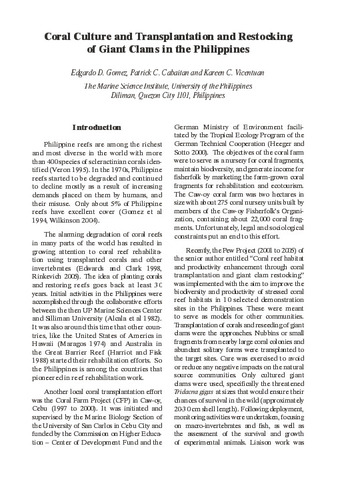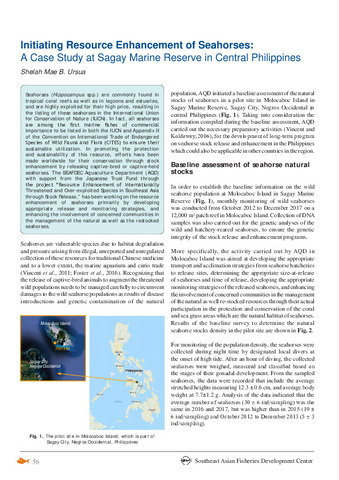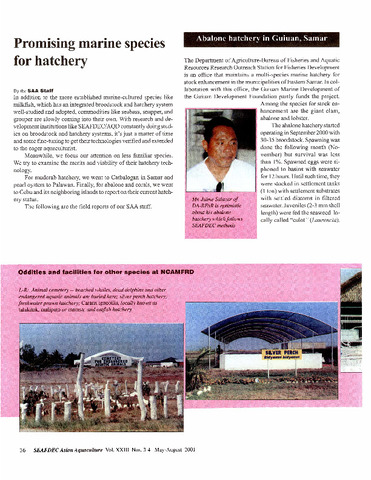| dc.contributor.author | Heeger, Thomas | |
| dc.contributor.author | Sotto, Filipina B. | |
| dc.contributor.author | Gatus, Joey Ll. | |
| dc.contributor.author | Laron, Criteta | |
| dc.contributor.editor | Garcia, Luis Maria B. | |
| dc.date.accessioned | 2013-12-02T05:49:59Z | |
| dc.date.available | 2013-12-02T05:49:59Z | |
| dc.date.issued | 2001 | |
| dc.identifier.citation | Heeger, T., Sotto, F. B., Gatus, J. L., & Laron, C. (2001). Community-based coral farming for reef rehabilitation, biodiversity conservation and as a livelihood option for fisherfolk. In L. M. B. Garcia (Ed.), Responsible Aquaculture Development in Southeast Asia. Proceedings of the Seminar-Workshop on Aquaculture Development in Southeast Asia organized by the Aquaculture Department, Southeast Asian Fisheries Development Center, 12-14 October 1999, Iloilo City, Philippines (pp. 133-145). Tigbauan, Iloilo, Philippines: Aquaculture Department, Southeast Asian Fisheries Development Center. | en |
| dc.identifier.isbn | 9718511474 | |
| dc.identifier.uri | http://hdl.handle.net/10862/1811 | |
| dc.description.abstract | The present condition of marine resources in the Philippines is critical and a majority of coastal communities live below the poverty line. If it continues, the progressive degradation of coral reefs and overexploitation poses a dangerous trend. Coastal resource management strategies are facing a new challenge: the integration of social, economic and natural sciences in future concepts to reverse the current status of ecosystem destruction and improvement of the people s living conditions. Hence, the primary objective of the coral farm is to provide alternative livelihood to fisher families from their resources on a sustained basis. The second objective is the rehabilitation of degraded reefs. Currently coral colonies of 64 species are taken through fragmentation from the wild. After 6-12 weeks (depending on the species) of grow-out in the farm, the fragments were deployed at the rehabilitation site at an average of 2 fragments per square meter (=12.5% cover). The survival of fragments is high at 84%, despite the fact that some coral colonies were placed in unsuitable substrates by the fisherfolk. More trainings have to be conducted improve their knowledge of coral biology and community structure. The net cost of rehabilitating a one-hectare reef is U$2,100 for 12.5% cover. Additional profit from coral marketing is used for community projects identified by the folk. In this case, coral farming may be an option for livelihood and a cost-effective tool for reef rehabilitation. | en |
| dc.language.iso | en | en |
| dc.publisher | Aquaculture Department, Southeast Asian Fisheries Development Center | en |
| dc.subject | South East Asia | en |
| dc.title | Community-based coral farming for reef rehabilitation, biodiversity conservation and as a livelihood option for fisherfolk | en |
| dc.type | Conference paper | en |
| dc.citation.spage | 133 | |
| dc.citation.epage | 145 | |
| dc.subject.asfa | biodiversity | en |
| dc.subject.asfa | coral farming | en |
| dc.subject.asfa | coral reefs | en |
| dc.subject.asfa | livelihoods | en |
| dc.subject.asfa | resource conservation | en |
| dc.subject.asfa | sustainable development | en |
| dc.citation.conferenceTitle | Responsible Aquaculture Development in Southeast Asia. Proceedings of the Seminar-Workshop on Aquaculture Development in Southeast Asia organized by the SEAFDEC Aquaculture Department, 12-14 October 1999, Iloilo City, Philippines | en |



